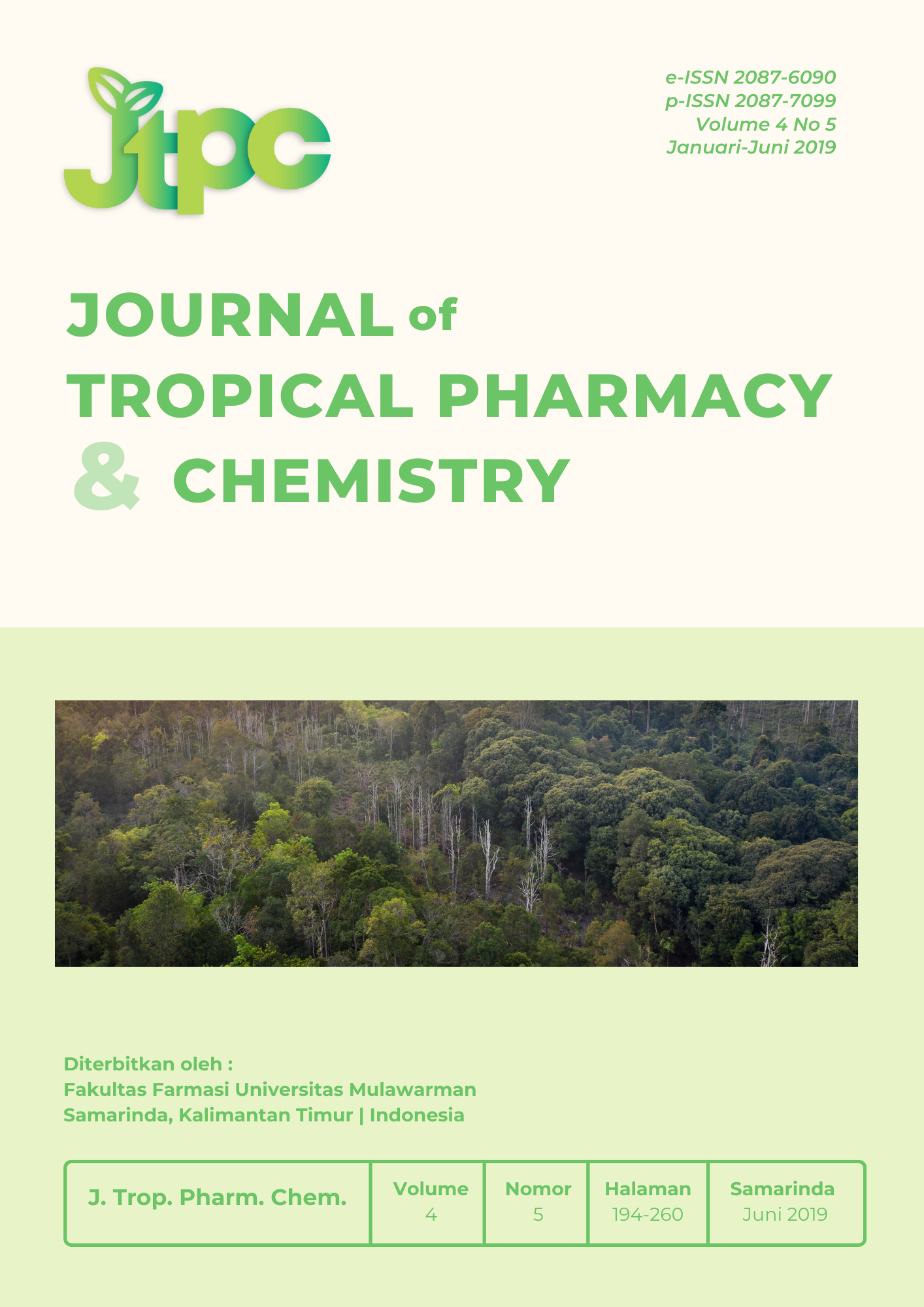Analysis of Total Phenolic from a Root Tabar Kedayan
DOI:
https://doi.org/10.30872/j.trop.pharm.chem.v4i5.274Keywords:
Tabar Kedayan (Aristolochia Foveolata Merr), Total Phenolic, SpectrophotometriAbstract
East Kalimantan has a diversity of plants from various Dayak ethnic groups. One of them is the Tabar Kedayan (Aristolochia foveolata Merr) plant located in Malinau district. This plant is empirically efficacious as antidiarrhea, antidotum (anti poison). Efficacy of Tabar Kedayan plant has not been scientifically confirmed, this is because there is still little scientific research and information about the content of secondary metabolites and bioactive compounds contained in Tabar Kedayan Root. The presence of secondary metabolite is phenolic which has considerable biological active prospects as antioxidant, antibacterial, antiamuba, anti-inflammatory, antihepatotoxic and antivirus. The aim of this research is to analyze the chemical content and total phenolic content of root tabar kedayan in fractionation with various nonpolar, semipolar and polar solvents. The analysis used in the determination of total phenolic content using visible spectrophotometric method. Data of analysis used standard curve method based on absorbance data and concentration of standard solution. The results of this study obtained the highest total phenolic average on ethyl acetate fraction of 77.74 ±2,633 mg GAE/g then ethanol fraction of water amounted to 38.10 ±0,461 mg GAE/g and the smallest level of n-hexane fraction of 29.36±0,193 mg GAE/g. Conclusions in this study total phenolic content is found in most semipolar fractions.
Downloads
References
Liwun, N.M. 2009. Inventarisasi dan Identifikasi Tanaman Obat yang Digunakan Oleh Suku Dayak Lundayeh di Kecamatan Muntarang Kabupaten Malinau Kalimantan Timur. KTI Akademi Farmasi Samarinda. Samarinda.Page 1-2.
Jubaidah, S. Apriliana, A. Wijaya, H. 2015. Uji Bioaktivitas Ekstrak Akar Tabar Kedayan (Aristolochia foveolata Merr). Media Sains 2nd edition. Vol 8. Published by Kopertis Wilayah XI Kalimantan. Page 69-75.
M.A. Soobrattee, V.S. Neergheen, A. Luximon-Ramma, O.I.Aruoma, O.T. Bahorun. 2005. Phenolics as potential antioxidant thera-peutic agents: mechanism and actions, Mutat. Res. Fundam. Vol.579. Page 200–213.
S. Geetha, M. Sai-Ram, S.S. Mongia, V. Singh, G. Ilavazha-gan, et al. 2003. Evaluation of antioxidant activity of leaf extract ofsea buckthorn (Hippophae rhamnoides L.) on chromium (VI) induced oxidative stress in albino rats, J. Ethnopharmacol. 87 Page 247–251.
Utami, Wahyu., Da’i, Muhammad., dan Negara, D. W. K., 2008. Uji Aktivitas Penangkap Radikal Bebas Fraksi Non Polar Ekstrak Etanol Daun Dewandaru (Eugenia uniflora L.) Dengan Metode DPPH (2, 2-diphenyl-1-picrylhidrazyl) Beserta Penetapan Kadar Fenol Dan Flavonoidnya. Jurnal Farmasi Indonesia. 2nd vol.9. Page 71.
Murtijaya, J. Lim Y.Y. 2007. Antioxidant Properties of Phylanthus amarus Extracts as Affected by Different Drying Methods, LWT-Food Sci. Technol, 40. Page 1664-1669.
Turisman, Ardini, P. Nofiani, R. 2012. Total Fenol Fraksi Etil Asetat Dari Buah Asam Kandis (Garcinia dioca Blume). JKK. 2nd vol.1. Page 45-48.
Kaur, C. Kapoor, C.H. 2002. Anti?oxidant activity and total phenolic content of some Asian vegetables. International Journal of Saince plus Technology. 2nd vol.37. Page 159-161.
Alfian, R. Susanti, H. 2012. Penetapan Kadar Fenolik Total Ekstrak Metanol Kelopak Bunga Rosella Merah (Hibiscus sabdariffa Linn) dengan Variasi Tempat Tumbuh Secara Spektrofotometri. Jurnal Ilmiah Kefarmasian. 1nd vol 2. Page 78.
Nur, A.M., Astawan, M. 2011. Kapasitas Antioksidan Bawang Dayak (Eleutherine palmifolia) Dalam Bentuk Segar, Simplisia dan Keripik, Pada Pelarut Nonpolar, Semipolar dan Polar. Skripsi. Bogor: Departemen Ilmu dan Teknologi Pangan Institut Pertanian Bogor.
Rohman, A., Riyanto, S., Utari, D. 2006. Aktivitas Antioksidan, Kandungan Fenolik Total dan Kandungan Flavonoid Total Ekstrak Etil Asetat Buah Mengkudu Serta Fraksi-fraksinya. Jurnal MFI. 3 nd Vol. 17. Page. 136-142.
Rahman, M., Habib, R., Hasan, R., Islam, A.M.T., Khan, I.N. 2012. Comparative Antioxidant Potential Of Different Extracts Of Flacourtia Jangomas Lour Fruits. Asian Journal of pharmaceutical and Clinical Research. 5(1):73-75.




